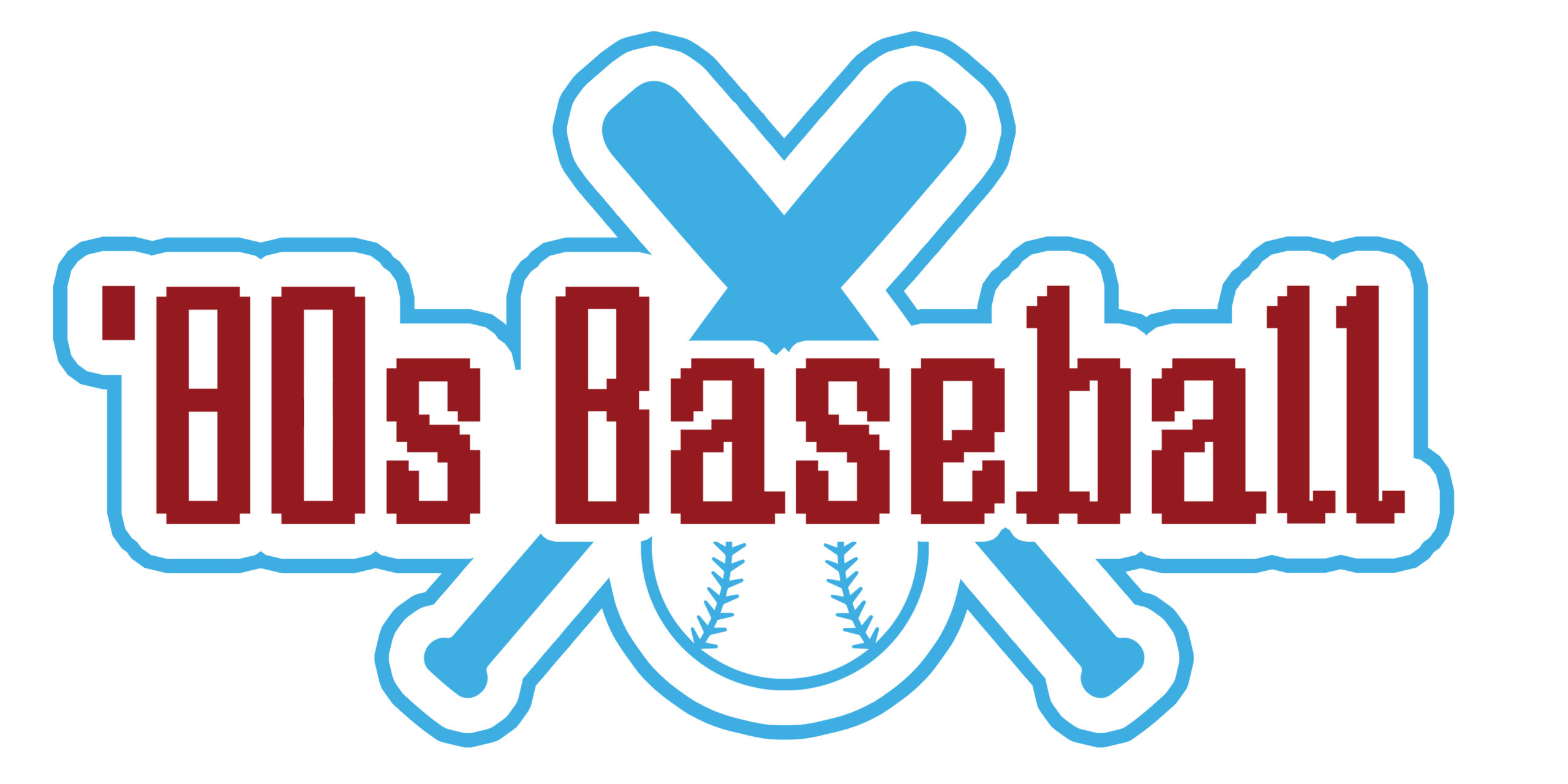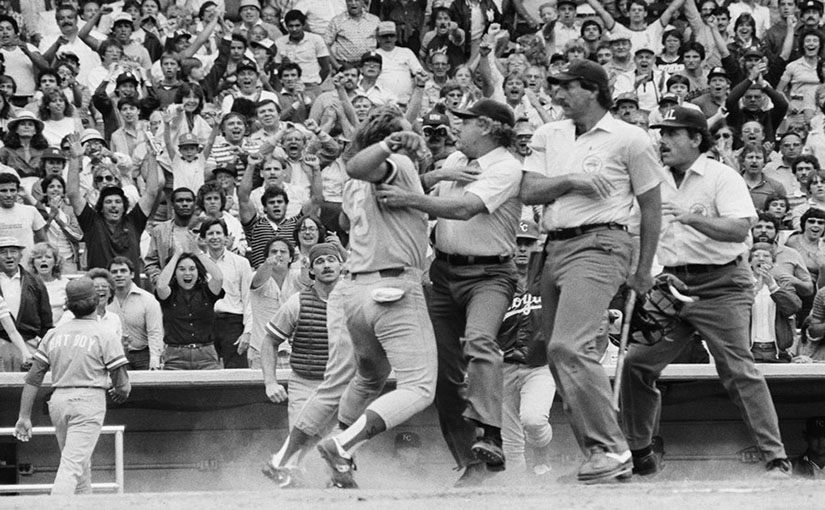Note: This is a guest post from Rocco Constantino
July 24, 1983
The old baseball cliché is that you see something new at the ballpark every time you go to a game. It could be something as simple as a player recording his first major-league hit or achieving a team record; however, sometimes something so crazy will happen that it will be talked about in baseball circles for decades.
On July 24, 1983, fans undoubtedly witnessed the latter. The Yankees and Royals had one of the game’s best rivalries in the late ’70s and early ’80s. The teams met in the postseason in the 1976, 1977, 1978, and 1980 ALCS, and the main cast of characters was similar in each series. The Royals were led by George Brett, Frank White, Hal McRae, and Willie Wilson, among others. The Yankees featured Graig Nettles, Reggie Jackson, Ron Guidry, and Goose Gossage during that time.
The Background
By 1983, the Yankees were starting to get old but still had some fight in them. The Orioles and Tigers were the up-and-coming teams and would finish ahead of the Yanks in the AL East standings. The Royals finished second that year but were never really in the race, ending the season 20 games out of first. With Wilson, White, and McRae still in their prime, the Royals lineup was tough to negotiate for any pitcher. But Brett remained the focal point of the offense and was an incredibly difficult out for pitchers. “Brett was the toughest hitter I faced in my career,” said Don August, a starter for the Brewers whom Brett went 5-for-11 against. “I remember him standing way off the plate when I faced him, so I put a fastball on the outside corner. He hit it off the center-field wall. Next time up, I tried to come inside, and he turned on it and ripped it into the corner. How do you get Brett out? I guess throw it down the middle and hope he hits it at someone.”
The Yankees had taken two of the first three games in this four-game set and faced off against the Royals in a Sunday afternoon game at Yankee Stadium on July 24. Bud Black and Shane Rawley were the starting pitchers for the Royals and Yankees, respectively, but they would be long gone by the time the events that made this game famous happened.
The Game
The first inning went by without incident, and the Royals were the first to get on the board when John Wathan scored on a groundout by White in the second. The Yankees quickly tied the game up when Dave Winfield homered off Black. The Royals regained the lead in the fourth when White again drove home Wathan, this time with an infield hit. Black settled in after the Winfield homer, only allowing singles to Bert Campaneris and Roy Smalley as the game remained 2–1 through five. In the sixth, the Royals scored again on a triple to center by Don Slaught. The Yankees, however, would finally get to Black in the sixth. Campaneris led off the frame with an infield hit, and Lou Piniella followed with a one-out single to center. Don Baylor tripled to center to tie the game, and Winfield singled to left to give the Yanks a 4–3 lead.
The game stayed that way until the top of the ninth. Despite having Gossage, the Hall of Fame closer, available in the bullpen, manager Billy Martin stuck with Dale Murray, who had retired all eight batters he faced to that point. Slaught grounded out to lead off the top of the ninth, and Pat Sheridan popped up to first for a second out. However, U. L. Washington singled to center, and with Brett due up next, Martin opted to bring in Gossage. Brett launched a long home run to right off Gossage for what was apparently the go-ahead hit. He circled the bases, touched home, and took a seat in the Royals dugout next to Sheridan and McRae. What happened was iconic ’80s baseball.
In a game in 1975, Nettles was involved in a play in which a similar illegal bat was used. According to an archaic rule stating that no substance could be applied to a bat beyond 18 inches from the knob. The Yankees were facing the Twins on July 19, 1975. In the game, Twins manager Frank Quilici asked umpires to check Thurman Munson’s bat after he hit an RBI single. The umpires ruled that Munson’s pine tar exceeded 18 inches and called him out. The rule allegedly was put into place because players were applying pine tar toward the barrel of the bat and then using it to get a better grip. While the application of pine tar was not illegal, rules were changed to limit the application to 18 inches above the knob because too many batted balls were coming in contact with the pine tar and causing otherwise perfectly good baseballs to be thrown out of play because they were stained.
Nettles had approached Martin earlier in the year when he noticed that Brett’s bat had pine tar that was obviously well past the 18-inch limit. The Yankees manager decided to wait until the right time to appeal Brett’s bat to the umpire. The Yanks had played the Royals earlier that year, but Brett didn’t have any big hits in the previous series, so Martin declined to call him on it. The home run he hit on July 24, 1983, was the perfect time.
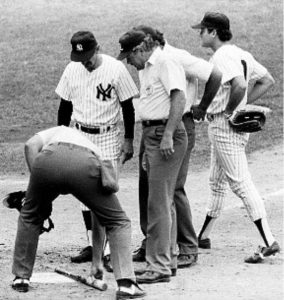 Martin approached home plate umpire Tim McClelland with his concerns. The umpires convened, and third-base umpire Nick Bremigan suggested that crew chief Joe Brinkman measure the bat against home plate, which is 17 inches wide. It was estimated that the pine tar stretched more than 25 inches past the bat handle, clearly past the limit. The problem that ensued was that there was no specific penalty listed for someone who had applied material past the 18-inch mark. Martin was ready for this and suggested the umpires invoke a rule stating that the umpires have the right to make any decision on any penalties not specifically listed in the rule book.
Martin approached home plate umpire Tim McClelland with his concerns. The umpires convened, and third-base umpire Nick Bremigan suggested that crew chief Joe Brinkman measure the bat against home plate, which is 17 inches wide. It was estimated that the pine tar stretched more than 25 inches past the bat handle, clearly past the limit. The problem that ensued was that there was no specific penalty listed for someone who had applied material past the 18-inch mark. Martin was ready for this and suggested the umpires invoke a rule stating that the umpires have the right to make any decision on any penalties not specifically listed in the rule book.
Slaught was sitting near Brett in the dugout during all of this: “I was sitting right near George, still in my equipment,” said Slaught. “Someone said, ‘Hey I think they’re gonna call you out.’ George said, ‘If they call me out, I’ll kill them.’” At about the same time, McClelland took a few steps toward the Royals dugout, with Brett’s bat in hand. McClelland raised his right hand, pointed at Brett with the bat, and called him out. After that, pure insanity erupted.
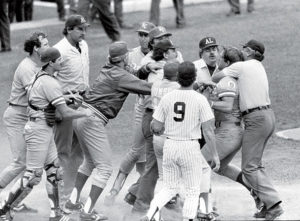 Brett jumped off the dugout bench and sprinted at McClelland, arms flailing and furiously screaming at the umpire, who stood 6’6″. Brinkman grabbed Brett with a choke hold, and Brett began screaming and struggling to get loose as the entire Royals bench emptied onto the field. Almost as mad as Brett was Royals manager Dick Howser, who furiously protested the call. In the fracas, Hall of Famer Gaylord Perry grabbed the bat from McClelland and handed it down in a relay to a Royals batboy, who went toward the clubhouse. Yankee Stadium security noticed this and, along with the umpires, sprinted down the runway after the illegal bat.
Brett jumped off the dugout bench and sprinted at McClelland, arms flailing and furiously screaming at the umpire, who stood 6’6″. Brinkman grabbed Brett with a choke hold, and Brett began screaming and struggling to get loose as the entire Royals bench emptied onto the field. Almost as mad as Brett was Royals manager Dick Howser, who furiously protested the call. In the fracas, Hall of Famer Gaylord Perry grabbed the bat from McClelland and handed it down in a relay to a Royals batboy, who went toward the clubhouse. Yankee Stadium security noticed this and, along with the umpires, sprinted down the runway after the illegal bat.
“It was wild,” said Slaught. “Steve Renko and some of the guys were running around the hallways looking for the bat, and security was running right behind them through the halls.” Eventually, the bat was confiscated by the umpires and sent to American League president Lee MacPhail for investigation.
The Aftermath
The Royals filed a formal protest against the ruling and waited for a final decision to be made by MacPhail. MacPhail ruled in favor of the protest, citing the rule’s archaic nature, the fact that the pine tar did nothing to enhance the ball’s contact off the bat, and an incorrect penalty by the umpires. MacPhail stated that the way he read the rules, the umpires should’ve just removed the bat and continued play from there. The bat was eventually returned to Brett. He removed the excess pine tar, drew a line with a red marker around the 18-inch mark, and continued to use it in games. But Perry advised Brett that the incident was so unique that his bat was a baseball artifact and he shouldn’t risk breaking it. Brett agreed and eventually sold the bat for $25,000; however, Brett rethought the transaction and bought the bat back for the same amount. To this day, the bat is still on display at the Baseball Hall of Fame.
As for the game itself, MacPhail ruled that the remaining four outs would be played as part of a makeup on August 18. Martin and Yankees owner George Steinbrenner, always the competitors, were livid at the reversal. On August 18, the Royals returned to Yankee Stadium to finish the game. Howser, Brett, Perry, and Royals coach Rocky Colavito were ejected from the original game due to their actions in the melee that ensued during the initial ruling.
“It may have been the most nervous I was for a game in my career, even including the postseason,” said Slaught, who was in his second season in the bigs and went 3-for-4 in the game. “There were more reporters there than any postseason game that I played in. It was a weird, weird game. Gaylord Perry even had T-shirts made up for us and then tried to make us all buy them from him.”
The Conclusion
As the game was about to start, Martin appealed the fact that Brett actually touched every base. He contested that since it was an entirely different umpire crew, they would have no way of knowing that he indeed touched every base. But the umpires anticipated Martin might do this and had a sworn affidavit from the original crew stating that Brett did touch every base. Martin then informed the umpires that he was playing this game under his own protest.
When the action finally started, Martin made some lineup changes. Jerry Mumphrey, the original center fielder in the game, had been traded in the ensuing weeks and so was unavailable to continue. Martin decided to send his ace pitcher, Ron Guidry, out to center. He also inserted rookie Don Mattingly at second base. Mattingly, a lefty first baseman, became the first lefty to play a middle-infield position since Indians pitcher Sam McDowell in 1970. No lefty has played a middle-infield position since. Asked for his reasoning behind the moves, Martin said the resumption of the game was a mockery and he would play it like one.
With George Frazier pitching in relief for the Yanks, the game resumed. McRae, who was the on-deck batter when Brett homered, struck out to end the ninth. Royals closer Dan Quisenberry came on for the save and retired Mattingly, Smalley, and Oscar Gamble in order to finally give the Royals the 5–4 win in front of the 1,200 fans who showed up for the final four outs. Brett flying out of the dugout is something that will live on in the annals of baseball history. Brett, Martin, Perry, and Nettles were some of the most colorful characters in baseball, making the incident even more memorable.
The game itself brought the Royals to within one game of first place, but they went into a midseason slump, and that would be the closest they got to first place for the rest of the year. In the years after, all parties involved looked back on the incident with a sense of humor, accepting their place in baseball history and laughing about the events surrounding the end of the game. Brett went on to have one of the greatest careers in baseball history. He finished the 1983 season with a .310 batting average and went on to record 3,154 hits in his career. He maintained his reputation as an intense player who was willing to do anything he could to play the game and play it well. “Brett was just a regular guy, but incredibly talented,” said Andy McGaffigan, who was Brett’s teammate between 1990 and 1991. “He showed up and played hard and played hurt. He would DH, play third, play first, whatever it took to be in the lineup that day. He had no pride or ego, and that was contagious. It’s what made him a great leader.” Another of Brett’s teammates agreed with that assessment: “He was the best pure hitter I ever played with,” said Jim Wohlford, who played with Brett the first four years of his major-league career. “You just knew the special talent was there, even as a 20-year-old kid.” Slaught also reflected on Brett’s greatness: “George always seemed to hit what we needed,” said Slaught. “It was unbelievable. If we needed single or double, that’s what he seemed to hit. Look at the pine tar game; we needed a homer and that’s what he hit. He was the guy that did that the best of anyone I played with.” There are so many reasons George Brett is considered one of the greatest players in the history of the game. His clutch performance in the game and wild outburst after he was called out were two iconic moments in one of the most colorful and productive careers in baseball history.
About Rocco Constantino
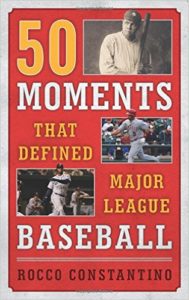 Rocco Constantino is the author of 50 Moments that Defined Major League Baseball (Rowman & Littlefield, 2016) and a writer for www.baseballhotcorner.com. Released in June of 2016, 50 Moments that Defined Major League Baseball examines 50 unique moments from the past 100 years that helped define the sport that we love. In addition, it also features exclusive interviews with over 40 players who played in each decade from the 1950’s through the 2010’s. With input from players like Fred Lynn, Rod Carew and Jeff Montgomery, readers get a perspective on these special games directly from the players. 50 Moments that Defined Major League Baseball is available on Amazon and Barnes and Noble’s online store. Rocco Constantino is represented by P.S. Literary. Follow him on Twitter @MLB100years.
Rocco Constantino is the author of 50 Moments that Defined Major League Baseball (Rowman & Littlefield, 2016) and a writer for www.baseballhotcorner.com. Released in June of 2016, 50 Moments that Defined Major League Baseball examines 50 unique moments from the past 100 years that helped define the sport that we love. In addition, it also features exclusive interviews with over 40 players who played in each decade from the 1950’s through the 2010’s. With input from players like Fred Lynn, Rod Carew and Jeff Montgomery, readers get a perspective on these special games directly from the players. 50 Moments that Defined Major League Baseball is available on Amazon and Barnes and Noble’s online store. Rocco Constantino is represented by P.S. Literary. Follow him on Twitter @MLB100years.
